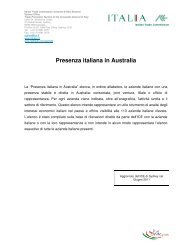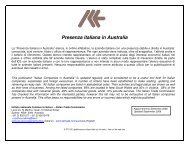Price Determination in the Australian Food Industry A Report
Price Determination in the Australian Food Industry A Report
Price Determination in the Australian Food Industry A Report
You also want an ePaper? Increase the reach of your titles
YUMPU automatically turns print PDFs into web optimized ePapers that Google loves.
Observations<br />
The price comparison shows that <strong>the</strong>re is a general price trend which sees broad consistency <strong>in</strong><br />
movement across farmgate, wholesale and retail prices compared with that seen <strong>in</strong> beef. In <strong>the</strong><br />
past couple of years where export returns have led farmgate prices, prices at retail have generally<br />
followed those at wholesale and farmgate.<br />
Higher value cuts have <strong>in</strong>creased at a greater level relative to legs and forequarter chops. This<br />
<strong>in</strong>dicates a stronger demand for premium product and cuts as consumers become more conscious<br />
of <strong>the</strong> products <strong>the</strong>y purchase.<br />
PORK – OVERVIEW<br />
Background<br />
Pork is a major retail fresh meat category, yet its fortunes are largely determ<strong>in</strong>ed by its end use <strong>in</strong><br />
processed meats, a market to which o<strong>the</strong>r red meats are less exposed. The pork sector has<br />
undergone significant adjustment <strong>in</strong> recent years with <strong>the</strong> removal of restrictions on <strong>the</strong><br />
importation of meat. Approximately 60 per cent of <strong>Australian</strong> pork production is consumed <strong>in</strong> <strong>the</strong><br />
manufactured meat and smallgoods sectors – this volume varies accord<strong>in</strong>g to <strong>the</strong> competitiveness<br />
of local product <strong>in</strong> <strong>the</strong> face of commodity imports.<br />
Various factors have affected <strong>the</strong> pork value cha<strong>in</strong> <strong>in</strong> recent years. Producers’ marg<strong>in</strong>s have been<br />
squeezed due to cost pressures associated with <strong>the</strong> drought and high feed prices, and <strong>the</strong>ir<br />
returns are be<strong>in</strong>g negatively affected by <strong>in</strong>creased imports and a higher <strong>Australian</strong> dollar.<br />
Smallgoods manufacturers and retailers, however, have benefited from <strong>the</strong> <strong>in</strong>creased availability<br />
of lower priced imported product and lower domestic prices for fresh pork <strong>in</strong> comparison to o<strong>the</strong>r<br />
meats.<br />
<strong>Price</strong> <strong>Determ<strong>in</strong>ation</strong> <strong>in</strong> <strong>the</strong> <strong>Australian</strong> <strong>Food</strong> <strong>Industry</strong> A <strong>Report</strong><br />
<strong>Industry</strong> response has been to seek greater demand for fresh <strong>Australian</strong> pork products and cuts <strong>in</strong><br />
domestic and export markets (which have <strong>in</strong>cluded chilled pork to Japan and S<strong>in</strong>gapore). These<br />
markets are for chilled product which has provided higher returns than domestic end uses, based<br />
on <strong>the</strong> <strong>in</strong>dustry’s competitive advantages of transport proximity, herd health status and product<br />
<strong>in</strong>tegrity.<br />
Figure 44. Share of pork product market, 2002<br />
Source: ABS<br />
fresh<br />
exports<br />
16%<br />
imports<br />
16%<br />
Major drivers of pork prices<br />
domestic fresh<br />
18%<br />
domestic<br />
processed<br />
50%<br />
• Returns to <strong>the</strong> production sector of <strong>the</strong> <strong>in</strong>dustry from domestic and export markets for pork are<br />
determ<strong>in</strong>ed by a set of forces affect<strong>in</strong>g various pork cuts <strong>in</strong> <strong>the</strong> product–market mix.<br />
• In <strong>the</strong> domestic market, imports from Canada and Denmark have <strong>in</strong>creased price competition <strong>in</strong><br />
<strong>the</strong> smallgoods sector with <strong>the</strong> import of leg meat from Canada and bellies from Denmark.<br />
Imports from <strong>the</strong>se production <strong>in</strong>dustries are seasonal and dependent upon currency factors.<br />
• Our <strong>in</strong>dustry is at a cost disadvantage to <strong>the</strong>se suppliers due to <strong>the</strong>ir production scale, low feed<br />
costs and process<strong>in</strong>g costs.<br />
48







